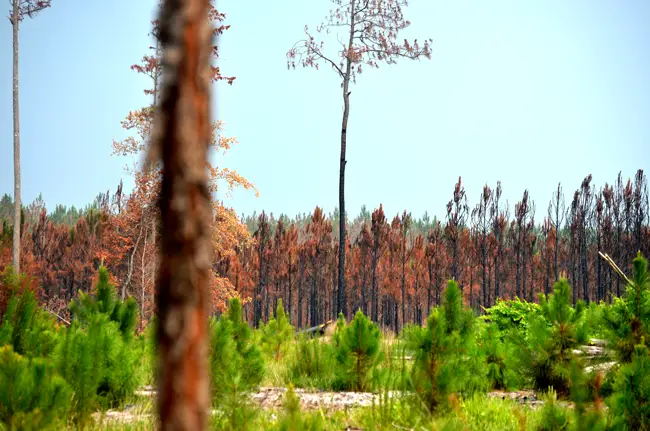
“Finally.”
That’s the word from Flagler County Fire Chief Don Petito today as the county’s burn ban, in effect for most of the time since December, was lifted, and the number of active fires in the county—which peaked at two dozen a month ago—dwindled to just two.
Click On:
- $460,000 And Counting: With Federal Aid Unlikely, Flagler Will Bear Fires’ Entire Costs
- 2 Firefighters Killed in N. Florida, Underscoring Dangers of Violent Flares on Contained Fires
- Big Stand Against Espanola Fire at Threatened FPL Powerlines In Hopes of Halting Blaze
“I Saw The Fires As I Was Flying In.” Rick Scott’s Embarrassing Lay-Over in Flagler
Persistent rains since the last week of June lowered the drought index to 418 by this morning, on a scale of 800, with 800 being absolutely dry and zero being fully saturated. “I know it’s going to be somewhere in the threes after all this rain,” Petito said, citing Monday’s downpours, which filled swales again near the county’s Emergency Operations Center in Bunnell.
For residents, lifting the burn ban means firing up grills and campfires is acceptable again, but throwing cigarette butts out the window and lighting up fireworks in subdivisions (or anywhere else, without a permit) still isn’t. Yard-waste burning is permissible on the west side of the county, and landowners can burn portions of their land, in controlled burns, but in either case, only with a permit from the Division of Forestry.
The Espanola fire, always the largest one, is still burning, but it’s 70 percent contained, and mostly “just a lot of smoldering deep underground,” Petito said. It’s being monitored by the Division of Forestry. Its acreage hasn’t changed in two weeks: 5,136 acres. The Opossum fire is also still burning, in a mucky swamp off of County Road 13, not far from the county fairgrounds, over a couple of dozen acres. The Division of Forestry is also working that fire, but with its district firefighters. The division’s so-called Type 2 team from the state left almost two weeks ago as the emergency dissipated. Espanola and Opossum will keep burning until “they burn themselves out or there’s enough rain to smother them out,” Petito said.
Wetter conditions are a radical change from the second and third weeks in June, when the Espanola fire alone had more than 200 firefighters on its case, when Gov. Rick Scott declared a statewide emergency, when the National Guard assigned two to three Black Hawk helicopters to Flagler County to help fight the fires, and when the county’s 76 firefighters were on mandatory 36-hour shifts to ensure against any wildfire emergency. The cost to the county was steep: about half a million dollars, wiping out the $300,000 emergency fund and requiring the administration to dip into various contingencies to make up the rest.
A significant silver lining: not a single structure was lost to the fires, only a few minor injuries were recorded, and the county’s fire department experienced no equipment loss. “They were able to keep all the trucks running and do enough repair that we didn’t have to replace anything,” Petito said. The half million dollars was charged to overtime, food and fuel, among other things.
The state could have applied for federal aid that would have reimbursed the county (and the state) under a provision of the Federal Emergency Management Administration. The state chose not to. It had applied for such aid in five other fires in the state, and won reimbursements for just one.
The May-June fire season lasted longer than usual because June rains didn’t start until much later. The turn-around was June 24, when the National Weather Service issued a flood advisory for parts of Flagler County and skies opened up on Bunnell. Lightning was still triggering new fires (including 12 that day), but they were much smaller and were contained much faster.
As of today, there were 16 active wildfires of over 100 acres in Florida, and a total of 73 active wildfires, most of them in the northeast and the Panhandle sections of the state. Between January 1 and July 10, there were 3,915 fires in the state, burning 200,000 acres.





























Leave a Reply